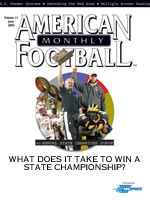AMERICAN FOOTBALL MONTHLY THE #1 RESOURCE FOR FOOTBALL COACHES
Article CategoriesAFM Magazine
|
Defending the Red ZoneAdjusting Man Free in the Red ZoneDefensive Coordinator , Christopher Newport University © More from this issue All football coaches understand the importance of winning those two or three games each season that are won (or lost) by a touchdown or less. The difference in those types of games can usually be determined by getting at least one big stop in the red zone. We spend two 15-minute segments per week on our red zone package. Our red zone coverages are easy adjustments (1 zone and 1 man) from our base coverages. In this article we will concentrate on those red zone adjustments from our man-free scheme.
|
|
|||||||
| HOME |
MAGAZINE |
SUBSCRIBE | ONLINE COLUMNISTS | COACHING VIDEOS |
Copyright 2025, AmericanFootballMonthly.com
All Rights Reserved





